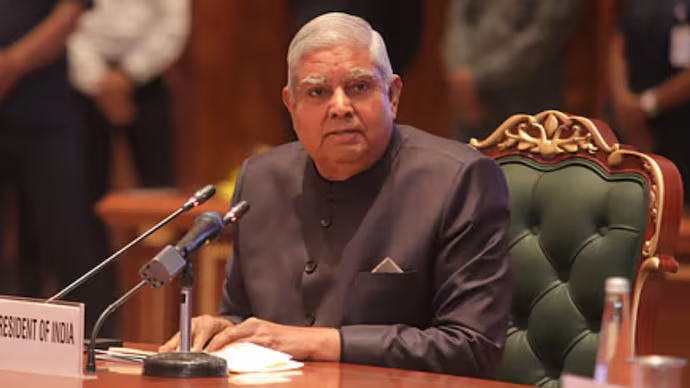New Delhi: The sudden resignation of Vice President Jagdeep Dhankhar has sent shockwaves through the Indian political landscape, dominating headlines for the past 24 hours. Despite a flurry of speculation, the real reason behind his unexpected exit remains unclear. The resignation, tendered late Monday night and accepted by President Droupadi Murmu on Tuesday, has raised a host of questions about timing, political undercurrents, and internal party dynamics.
A Sudden Resignation Raises Eyebrows
The timing of Dhankhar’s resignation has been one of the most puzzling aspects of the development. His official visit to Jaipur was scheduled for July 23, yet the resignation was submitted abruptly the night before. Was illness the genuine reason, as unofficial sources claimed? If so, how was he actively presiding over the Monsoon Session in the days leading up to his departure? Some observers suggest internal rifts within the BJP leadership or his increasing proximity to opposition leaders may have played a role. Others speculate whether he resigned on his own accord or was compelled to step down.
The Ministry of Home Affairs swiftly issued a gazette notification following the President’s acceptance of the resignation. Dhankhar did not attend the Rajya Sabha session on Tuesday, with Deputy Chairman Harivansh presiding instead. Prime Minister Narendra Modi also took to social media to wish Dhankhar good health, further fueling speculation about his sudden departure.
Political Intrigue: Clues from Jairam Ramesh’s Post
Congress leader Jairam Ramesh added fuel to the fire by sharing a detailed timeline on social media. According to him, Dhankhar chaired the Business Advisory Committee (BAC) meeting at 12:30 PM on Monday in the presence of BJP leaders JP Nadda and Kiren Rijiju. However, during the follow-up meeting at 4:30 PM, both were conspicuously absent. Ramesh hinted that something significant transpired between these meetings that may have influenced Dhankhar’s decision to step down. He also questioned the intent of those who had elevated Dhankhar to the Vice President’s office.
Was the Rajya Sabha Session the Flashpoint?
Events in the Rajya Sabha on Monday also appear to have been a turning point. At 11:35 AM, Leader of Opposition Mallikarjun Kharge demanded a discussion on the Pahalgam attack and Operation Sindoor. Despite repeated government interventions, Dhankhar didn’t allow BJP chief JP Nadda to speak initially, granting him a chance only four minutes later. This led to a noisy uproar from opposition MPs. Nadda’s strong remark — “Only my words will be recorded” — appeared aimed more at the opposition than the Chair, but tensions were palpable.
At 4:07 PM, Dhankhar officially announced that he had received a notice from 63 opposition MPs seeking an impeachment motion against Justice Verma. The revelation shocked many, including the government, and reportedly led to an emergency meeting of BJP MPs in Rajnath Singh’s office. Sources claim some MPs were made to sign documents without being told they pertained to the impeachment motion — a move seen as a major political misstep for the ruling party.
A Controversial Tenure Comes to a Close
Jagdeep Dhankhar’s tenure as Vice President was marked by frequent controversy. Previously as West Bengal Governor, he had numerous public confrontations with Chief Minister Mamata Banerjee. After assuming the Vice President’s office, opposition leaders repeatedly accused him of showing bias toward the BJP. In 2023, he stirred fresh outrage by claiming that protestors in the farmers’ movement were “not real farmers,” drawing sharp criticism from farmer unions.
The December 2023 Winter Session saw another major controversy when Dhankhar suspended 34 Rajya Sabha MPs, part of the unprecedented suspension of 141 MPs across both Houses. The situation escalated when TMC MP Kalyan Banerjee mimicked him during a protest, an act caught on video by Rahul Gandhi. Dhankhar later described the mimicry as an insult to his Jat and farmer heritage.
What Happens Next?
With Dhankhar’s departure, questions now arise about who will temporarily take over his responsibilities. However, the Indian Constitution does not provide for an interim Vice President. The Election Commission is expected to soon announce the schedule for the election of the next Vice President, who will serve a full five-year term, not just until 2027.
How Is the Vice President Elected?
The Vice President is chosen not by the public but through a vote by members of both Lok Sabha and Rajya Sabha. As of now, there are 782 MPs in Parliament, with a simple majority of 392 votes required for victory. The election process includes nominations, campaigning, and a ranked voting system.
Who Will Succeed Dhankhar?
Political circles are abuzz with potential names for the next Vice President, with speculation ranging from leaders in Bihar to those in Kerala. The BJP, opposition alliances, and regional parties are expected to engage in intense lobbying in the days ahead. With Dhankhar’s sudden exit, the road to Raisina Hill has become the center of India’s newest political drama.


